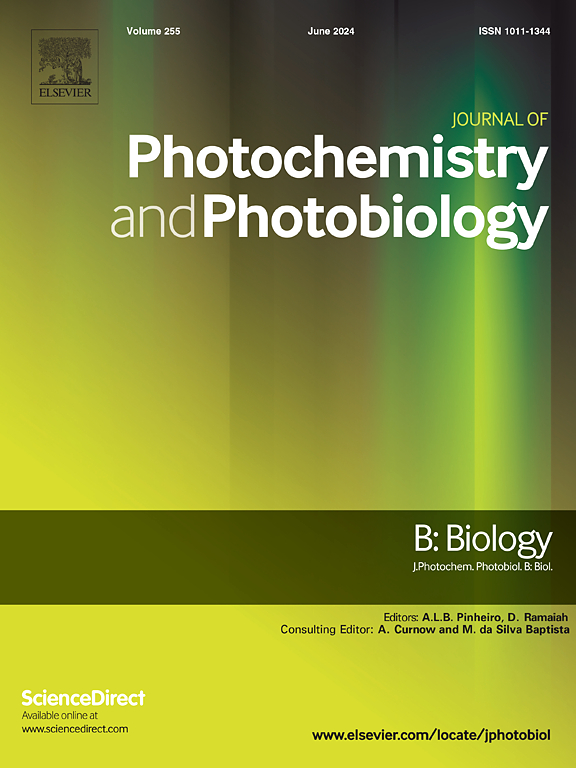Photobiomodulation using low-level laser therapy (LLLT) enhanced the osteogenesis of dental pulp stem cells
IF 3.7
2区 生物学
Q2 BIOCHEMISTRY & MOLECULAR BIOLOGY
Journal of photochemistry and photobiology. B, Biology
Pub Date : 2025-08-26
DOI:10.1016/j.jphotobiol.2025.113247
引用次数: 0
Abstract
Photo-biomodulation (PBM) has shown great potential in bone regeneration; therefore, we planned to investigate the use of different low laser parameters (LLLT) on hDPSCs' osteogenic differentiation potential. hDPSCs were expanded in culture media supplemented with different concentrations of FBS (1 %,5 %, and 10 %). Cells were exposed to different laser parameters using 810 nm diode laser for varying time periods. Cellular processes tested post-laser treatments (T1: 0.3 W/10s/3 J. T2: 0.4 W/10s/4 J. T3:0.8 W/3 s/2.4 J. T4: 1 W/3 s/3 J.). Cells seeded in different concentrations of FBS and not exposed to any laser parameter were kept as negative controls. Our results indicated that exposure of hDPSCs to high laser power (T3, T4) for a short time resulted in wider calcium deposits in comparison to the positive control. Reactive oxygen species (ROS) production was significantly decreased in all laser parameters in the 1 %FBS group compared to the control (p ≤ 0.05). An enhanced adhesive and wound healing potency was noted among the treated cells, cultured in different FBS concentrations, regardless of the laser treatment groups. For the transwell migration assay, our results showed that T3 and T4 significantly increased the migration potential of treated cells for all the serum concentrations. (p ≤ 0.05). In conclusion, exposing hDPSCs to a high-power laser for a short time period enhanced osteogenic differentiation by increasing the release of calcium deposits and the expression of functional osteogenic markers in vitro. LLLT lasers may have a crucial role in the process of regeneration and repair; thus, further studies are required to optimize the functional laser parameters for bone regeneration in clinical applications.
利用低强度激光进行光生物调节可促进牙髓干细胞成骨
光生物调节(PBM)在骨再生中显示出巨大的潜力;因此,我们计划研究不同低激光参数(LLLT)对hdpsc成骨分化潜能的影响。hDPSCs在添加不同浓度FBS(1%、5%和10%)的培养基中扩增。使用810 nm二极管激光器,将细胞暴露在不同的激光参数下,持续不同的时间。T1: 0.3 W/10s/ 3j, T2: 0.4 W/10s/ 4j, T3:0.8 W/ 3s /2.4 j, T4: 1 W/ 3s / 3j。细胞接种不同浓度的FBS,不暴露于任何激光参数作为阴性对照。我们的研究结果表明,与阳性对照相比,hdpsc短时间暴露于高激光功率(T3, T4)下导致钙沉积更宽。与对照组相比,1% FBS组各激光参数的活性氧(ROS)产量均显著降低(p≤0.05)。在不同FBS浓度培养的处理细胞中,无论激光治疗组如何,都注意到增强的粘附和伤口愈合能力。在transwell迁移实验中,我们的结果显示T3和T4在所有血清浓度下都显著增加了处理细胞的迁移潜力。(p≤0.05)。综上所述,短时间高功率激光照射hdpsc可通过增加钙沉积的释放和功能性成骨标志物的表达来促进体外成骨分化。LLLT激光可能在再生和修复过程中起着至关重要的作用;因此,需要进一步研究优化临床应用中骨再生的功能激光参数。
本文章由计算机程序翻译,如有差异,请以英文原文为准。
求助全文
约1分钟内获得全文
求助全文
来源期刊
CiteScore
12.10
自引率
1.90%
发文量
161
审稿时长
37 days
期刊介绍:
The Journal of Photochemistry and Photobiology B: Biology provides a forum for the publication of papers relating to the various aspects of photobiology, as well as a means for communication in this multidisciplinary field.
The scope includes:
- Bioluminescence
- Chronobiology
- DNA repair
- Environmental photobiology
- Nanotechnology in photobiology
- Photocarcinogenesis
- Photochemistry of biomolecules
- Photodynamic therapy
- Photomedicine
- Photomorphogenesis
- Photomovement
- Photoreception
- Photosensitization
- Photosynthesis
- Phototechnology
- Spectroscopy of biological systems
- UV and visible radiation effects and vision.

 求助内容:
求助内容: 应助结果提醒方式:
应助结果提醒方式:


